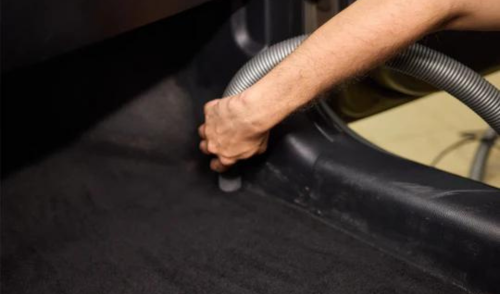Keeping your car mats clean is essential for maintaining the overall cleanliness and hygiene of your vehicle. Dirty car mats can harbour bacteria, allergens, and unpleasant odours, all of which can affect your driving experience.
This guide will provide you with everything you need to know about cleaning your car mats, ensuring they look good and last longer. Whether you have rubber mats, carpet mats, or TPE (Thermoplastic Elastomer) mats, we’ve got you covered.

Types of Car Mats
Rubber Mats
Rubber car mats are durable and easy to clean. They are designed to withstand heavy use and can handle all types of dirt and debris. Rubber mats are particularly useful in wet or muddy conditions as they are waterproof and can be quickly rinsed off.
Carpet Mats
Carpet car mats add a touch of luxury to your vehicle's interior. They are often chosen for their aesthetic appeal and comfort. However, they require more maintenance to keep them looking pristine, as they can easily accumulate dirt, stains, and odours.
TPE (Thermoplastic Elastomer) Mats
TPE car mats are eco-friendly, non-toxic, and known for their excellent durability and ease of cleaning. They combine the benefits of rubber and carpet mats, offering a perfect balance of functionality and style. TPE car mats are also resistant to extreme temperatures, making them an ideal choice for various climates.
General Cleaning Tips for All Mats
Before diving into the specific cleaning methods for each type of mat, here are some general tips that apply to all car mats:
- Tools and Materials Needed: Vacuum cleaner, brush, cleaning solution, water, and a drying rack or space.
- Preparation Steps: Remove the mats from your car and shake off any loose dirt and debris. This initial step is crucial for making the subsequent cleaning process more effective.
- Safety Precautions: Use gloves and ensure proper ventilation if using chemical cleaners to avoid any potential health hazards.
How to Clean Rubber Car Mats
What is the Best Way to Clean Rubber Car Mats?
Rubber car mats are relatively straightforward to clean due to their robust material.
- Removing Dirt and Debris: Start by shaking the mats vigorously to remove loose dirt. Use a vacuum cleaner to pick up any remaining debris.
- Recommended Cleaning Solutions: Mix water with a mild detergent or a specialised rubber mat cleaner. Apply the solution to the mats using a sponge or cloth.
- Scrubbing the Mats: Use a stiff brush to scrub the mats, paying special attention to any grooves or textured areas where dirt can accumulate.
- Rinsing: Rinse thoroughly with water to remove all soap residues. Ensure no detergent is left on the mats as it can become slippery.
- Drying Techniques: Hang the mats to dry completely before placing them back in your car. Proper drying prevents mould and mildew growth.
Can You Use a Pressure Washer on Rubber Mats?
Using a pressure washer can be an effective way to clean rubber mats, especially if they are heavily soiled. However, ensure you use a moderate setting to avoid damaging the mats. Hold the nozzle at a safe distance and move it evenly across the mat to clean it thoroughly without causing any harm.
How to Clean Carpet Car Mats
How Do You Remove Stains from Carpet Mats?
Carpet mats require more effort to clean, especially when dealing with stains.
- Identifying Stain Types: Determine the type of stain (e.g., coffee, mud, grease) to choose the appropriate cleaning method.
- Effective Stain Removal Methods: Blot the stain with a clean cloth to absorb as much liquid as possible. Apply a carpet stain remover and gently scrub with a brush. For homemade solutions, a mixture of vinegar and baking soda can be effective.
- Deep Cleaning: For stubborn stains, consider using a carpet cleaning machine or professional cleaning service.
How Often Should Carpet Mats Be Cleaned?
Carpet mats should be cleaned regularly, ideally once a month. However, the frequency can vary depending on usage and the environment. For example, mats in vehicles used in muddy or snowy conditions may require more frequent cleaning.
How to Clean TPE Car Mats
What Makes TPE Mats Easy to Clean?
TPE mats are designed to be highly resistant to stains and odours. Their smooth surface makes it easy to wipe away dirt and spills. They do not absorb moisture, making them less prone to mould and mildew.

- Simple Cleaning Process: Shake off loose dirt and debris. Wipe the mats with a damp cloth or sponge using a mild detergent. For tougher dirt, a brush can be used.
- Rinsing and Drying: Rinse with water and allow the mats to dry completely before reinstalling them in your car.
Are TPE Mats Resistant to Stains and Odours?
Yes, TPE mats are naturally resistant to stains and odours. Regular wiping with a damp cloth and mild detergent is usually sufficient to keep them clean. Their non-porous surface prevents the build-up of bacteria and other contaminants.
Drying and Maintenance
How to Properly Dry Your Car Mats
Proper drying is crucial to prevent mould and mildew. After cleaning, shake off any excess water and hang the mats in a well-ventilated area. If drying outdoors, avoid prolonged exposure to direct sunlight to prevent fading or warping.
Maintenance Tips for Prolonging the Life of Car Mats
- Regular Cleaning Schedule: Stick to a consistent cleaning routine to prevent dirt build-up and stains.
- Using Protective Sprays or Coatings: Consider using sprays that add a protective layer to your mats, making them easier to clean and more resistant to stains.
- Storage Tips: Store your mats flat or rolled up in a dry place when not in use to prevent creases or damage.
Share your cleaning tips and experiences in the comments below. If you have any questions, feel free to ask! Explore 3W’s range of high-quality, easy-to-clean car mats to keep your car looking its best.






Leave a comment
This site is protected by hCaptcha and the hCaptcha Privacy Policy and Terms of Service apply.